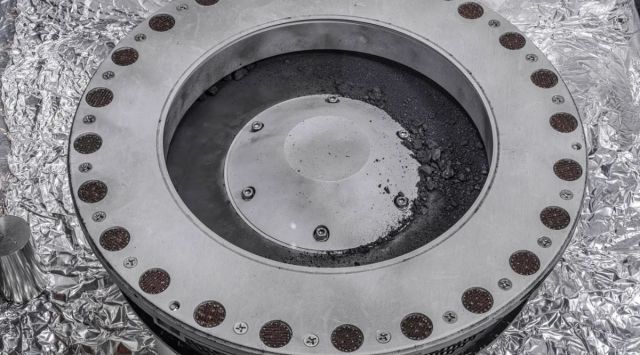Sample from asteroid Bennu rich in carbon and water: NASA
An initial study of a sample collected from the asteroid Bennu has revealed it contains abundant carbon and water. This could mean that the building blocks of life as we know it exists on the asteroid.
 The outside of the OSIRIS-REx sample collector. Sample material from the asteroid Bennu can be seen on the middle right. (NASA/Erika Blumenfeld & Joseph Aebersold)
The outside of the OSIRIS-REx sample collector. Sample material from the asteroid Bennu can be seen on the middle right. (NASA/Erika Blumenfeld & Joseph Aebersold) An initial study of the samples of asteroid Bennu brought back to Earth has revealed evidence of high carbon content and water. This indicates that the building blocks of life on our planet can also be found on the 4.5-billion-year-old asteroid.
The National Aeronautics and Space Administration (NASA) on Wednesday made the announcement from its Johnson Space Center in Houston. Scientists and leaders from the space agency showed off the asteroid material for the first time since the OSIRIS-REx mission dropped it to Earth.
 Image of the asteroid Bennu taken by the OSIRIS-REx mission (Image Source: NASA)
Image of the asteroid Bennu taken by the OSIRIS-REx mission (Image Source: NASA)
“The OSIRIS-REx sample is the biggest carbon-rich asteroid sample ever delivered to Earth and will help scientists investigate the origins of life on our own planet for generations to come. Almost everything we do at NASA seeks to answer questions about who we are and where we come from. NASA missions like OSIRIS-REx will improve our understanding of asteroids that could threaten Earth while giving us a glimpse into what lies beyond. The sample has made it back to Earth, but there is still so much science to come – science like we’ve never seen before,” said NASA Administrator Bill Nelson in a press statement.
The objective of the OSIRIS-REx mission was to collect 60 grams of asteroid material from Bennu and bring it back to Earth for analysis. NASA experts have spent more than ten days carefully disassembling the hardware used to return the sample. When the lid of the sample canister was first opened, scientists discovered “bonus” material covering the outside of the collector head, lid and base. There was so much material that it slowed the collection process, according to the space agency.
 The OSIRIS-REx sample return capsule can be seen here at the landing site, charred from its entry into Earth. (NASA/Keegan Barber)
The OSIRIS-REx sample return capsule can be seen here at the landing site, charred from its entry into Earth. (NASA/Keegan Barber)
Scientists began with a “quick-look” analysis of the initial material, where they collected images from a scanning electron microscope along with infrared measurements, X-ray diffraction and chemical element analysis. They also used X-ray computed tomography to produce a 3D computer model of one of the particles. This early “quick-look” gave evidence for the abundant presence of carbon and water in the sample.







